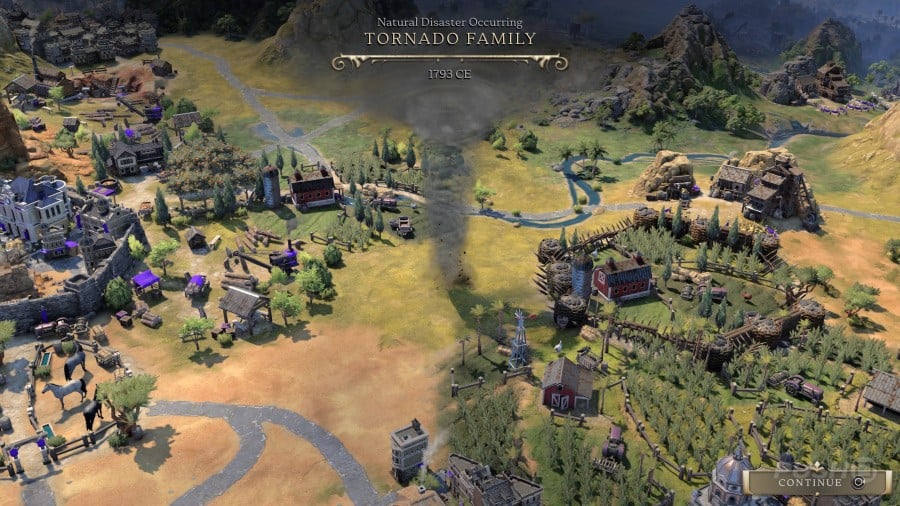

Firaxis has brought back its flagship series with Sid Meier’s Civilization VII, marking a historic first for the franchise by launching simultaneously on all platforms, including the PS5.
For newcomers, Civilization (often abbreviated as Civ) represents the classic 4X (eXplore, eXpand, eXploit, eXterminate) game where players guide their civilization from the dawn of time through modern eras, competing against AI adversaries to achieve victory in science, culture, or military dominance.
In evaluating this latest installment in the long-running series, it’s essential to draw comparisons to prior games, the most significant change being the introduction of the ‘Ages’ system.
Unlike earlier Civ titles where you progressed a single civilization over thousands of years, Civilization VII divides gameplay into three distinct eras: the Antiquity Age (comprising the Bronze and Iron Ages), the Exploration Age (including the Medieval and Renaissance periods), and the Modern Age (from the Industrial Revolution onward).

In each age, players control a different civilization that thrived during that period, adding a layer of dynamism to the gameplay. Each era introduces unique optional objectives that can lead to victory, allowing for a flexible strategic approach as the game evolves. As the first two ages conclude, crises arise that trigger escalating economic challenges until your civilization transitions into a new one.
Your choice of civilization for the next age depends on your leader and the accomplishments achieved in earlier gameplay. While iconic structures and cities remain intact, some buildings become outdated, paving the way for upgraded versions. Successfully navigating previous ages offers legacy bonuses that carry into the next, creating a sense of a cohesive campaign rather than isolated games.
This innovative approach has sparked debate among long-time fans, as it significantly alters the series’ traditional structure.

Another notable change is that leaders are no longer confined to a single civilization. Instead, a leader remains with you throughout the game, allowing for a blend of their distinct abilities with those of the civilizations you adopt in each age. This offers a fresh experience with every playthrough, as leaders can level up and gain additional minor abilities over time.
Some leader selections may seem unconventional and historically inaccurate; combining this with the new civilization-swapping mechanic could create jarring experiences for purists, such as encountering Benjamin Franklin leading the Mayans, followed by the Mongols, and then Germany.
City mechanics have also seen an overhaul. All settlements except for your capital begin as towns, which can specialize based on their surroundings as they develop. While towns can eventually transform into cities, choosing when to do so creates an engaging balance between ‘tall vs. wide’ strategies.

The combat system has been refined with the introduction of army commander units, allowing you to consolidate up to eight units into a single tile for coordinated movements across the map. Individual units can be deployed as necessary, returning to the classic one unit per tile combat style reminiscent of Civ VI. Reinforcements can swiftly be dispatched from allied cities at the push of a button, streamlining military operations and minimizing tedious movement management during extended campaigns.
Diplomatic interactions have also been revitalized, incorporating a new currency that influences both offer proposals and rejection to competitors. This feature extends to managing relations with barbarian factions and city-states, requiring you to make strategic decisions about resource allocation.
The inclusion of navigable rivers, a long-requested feature, enhances the relevance of naval units, particularly during the Exploration Age, enabling further exploration beyond initial borders.
When assessing the base version of Civ VII against its predecessors, which benefited from multiple expansions and DLCs, it’s unreasonable to find certain features like the World Congress absent. Many anticipate that these will be introduced in future expansion packs. Additionally, the limited variety of map types has resulted in less engaging world generation.

Moreover, the absence of the Earth map leaves true start location enthusiasts disappointed. Essential quality-of-life features, such as the option to re-roll maps if your starting position is unsatisfactory, are also missing. Players cannot even indulge in the infamous “one more turn” after completing a game, which has raised eyebrows.
Multiplayer options are available and include cross-play functionality, but the mode remains basic, lacking team functionalities and hot-seat gameplay.
Perhaps most surprising is that the third and final age only extends to the mid-twentieth century, leaving out modern units like helicopters and stealth bombers. Recent data mining leaks suggest that the omitted ‘Atomic Age’ appears to be cut content, likely to be released later as paid DLC. With additional content planned just weeks post-launch, many players feel frustrated by what they perceive as an incomplete game experience.

The game’s visuals are stunning, combining the realistic aesthetics of Civ V with the more stylized approach of Civ VI. Details abound, such as a tank crew repairing their vehicle or a scout climbing a lookout tower. Combat animations are visually impressive, and cities develop organically, with building renders integrated into the map. However, this can lead to overcrowding, making it challenging to discern details without zooming in or relying on tooltips.
Christopher Tin returns as composer, delivering an incredible soundtrack, including the main theme, “Live Gloriously.” Each civilization boasts its unique musical theme, immersing players in the respective cultures. Notably, Gwendoline Christie shines as narrator, joining iconic voices like Sean Bean and Leonard Nimoy in the ‘Civ Narrator Hall of Fame.’
Unfortunately, the user interface (UI) presents the most significant challenges in the game currently. A radial menu primarily organizes the main screens, which works adequately but makes accessing essential empire details complicated, particularly when trying to determine the reasons behind specific yield distributions.

In the later stages of gameplay, UI challenges can become overwhelming, leading to a sense of lost control as events unfold without clear reasons. The icons for units and cities are inadequately sized, requiring frequent zooming or reliance on tooltips for clarity. Additionally, crucial commands are often buried within sub-menus, and the UI’s color scheme can make distinguishing selected options difficult, increasing the risk of unintentional selections.
Like many console adaptations of complex genres, the controls may feel unwieldy at times, leading to a sluggish experience. Coupled with UI complications, this can detract from the pleasure of gameplay, though persistence will improve familiarity. Performance is generally solid, with quick load times, especially during the game’s initial phases.









